Camping Exploring Nature Waterplay baby Infant
Our Incredible Adventures with Baby - Part 2
To introduce babies to fresh air safely, dress them appropriately for the weather, keep them in the shade to protect their sensitive skin from sun exposure, and gradually increase the length of outdoor excursions as they get comfortable.
Benefits of Fresh Air for Babies
Sensory Development: Fresh air provides a rich sensory experience with new sights, sounds, and smells, which stimulates a baby's senses and supports brain development.
Improved Sleep:Exposure to natural daylight helps regulate a baby's internal body clock (circadian rhythm), leading to better sleep patterns, more consistent naps, and deeper rest.
Stronger Immune System: Exposure to a natural environment, including fresh air and diverse bacteria, can help strengthen a baby's developing immune system and build resistance to everyday germs.
Enhanced Mood and Behavior: Outdoor time has a calming effect on babies, often making them less fussy and more content. Well-rested babies also tend to exhibit better behavior and attention.
Vitamin D Production: Natural sunlight helps the body produce Vitamin D, which is crucial for building strong bones and supporting the immune system.
Stream River Camping Lake Other Adventures With Babies Baby
Waterplay Hiking & Camping Adventures with Babies
Waterplay, Hiking, And Camping Adventures With A Baby PDF
You will have all the links and Information at your finger tips
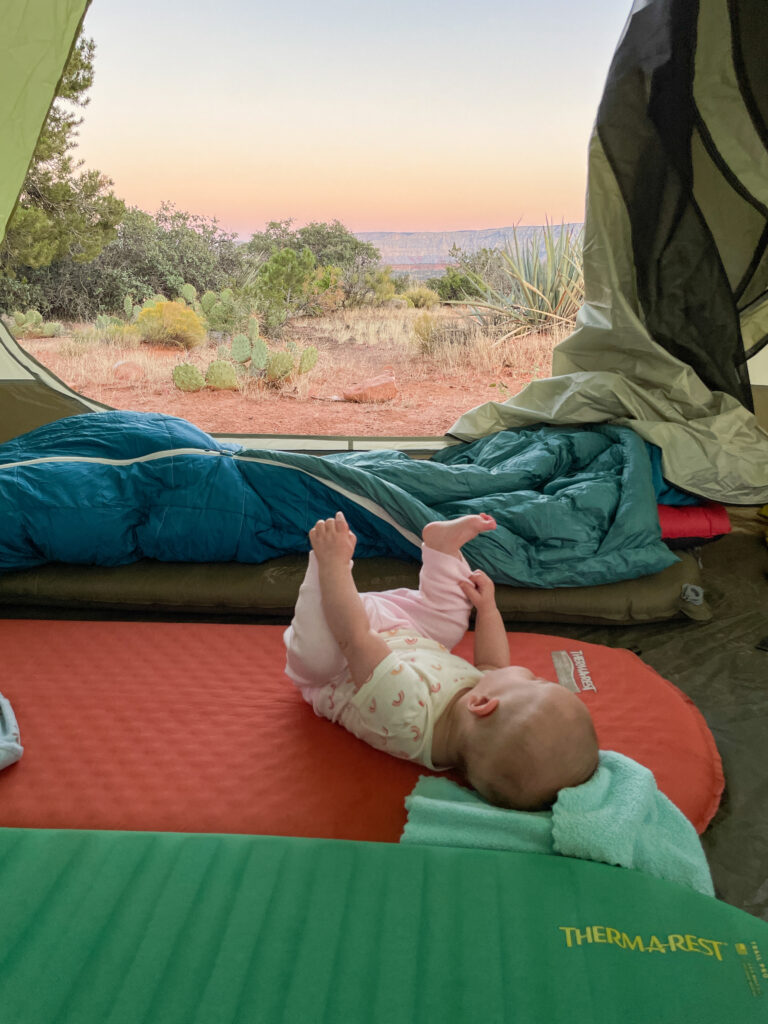
Welome To the Second Part of
Adventures With Babies
Adventures With Babies
CLICK HERE For Page One On Hiking & Adventure Planning
CLICK HERE For Page One On Hiking & Adventure Planning
♥
Our Series for Babies And Tots
Exploring The World
Exploring The World
Sensory Rich
Water Play
Plan a stress-free wild water day with your baby using these simple tips for packing, play, and safety. Keep it sweet, safe and full of summer joy.
The summer time brings lots of fun opportunities to get outdoors with your little one. One of the best places to head to is your local beach or lake, but as a new parent it can be overwhelming! Follow these easy tips and advice to make sure you are prepared and ready for anything your baby’s first beach day could throw at you. Also, download our free packing list to make sure you never miss an item when preparing for your first (or next) wild water day!
1. Timing Is Everything
Plan your visit around your baby’s natural rhythm. Early morning or late afternoon are usually the best times to hit the beach with an infant. You’ll avoid the harshest sun (noon to 4:00), the biggest crowds and the highest temperatures, plus your baby may be more rested and relaxed.
2. Shade Is Non-Negotiable
Babies under 6 months shouldn't be directly exposed to the sun, and even older babies need sun protection. Bring a pop-up tent, umbrella or a beach canopy for safe, cool shade. Look for options with built-in UV protection and good airflow.
Tip: It's also important to make sure your baby is shielded from the sun on all sides, not just from above, as the sand reflects UV rays.
3. Dress for Success
Lightweight, breathable clothing that covers your baby’s skin is key. A wide-brimmed hat and baby sunglasses with an adjustable strap are helpful for extra protection. If your baby is over 6 months, apply baby-safe mineral sunscreen to exposed skin about 30 minutes before sun exposure.
Tip: If you know your toddler is going in the water, dress them in brightly coloured swimsuits so it’s easier to spot them. Keep in mind that blue and green colours tend to look invisible in the water. This is also a great safety tip to practice in a pool!
4. Pack Smart, Pack Light
When you’re heading to the beach with a baby, it’s tempting to bring everything, but a streamlined bag makes for a smoother day. Focus on the must-haves: diapers and wipes, a sun hat, baby-safe sunscreen (for 6 months and up), a change of clothes, a lightweight blanket/towels, a couple of simple toys and plenty of snacks or bottles. A small cooler for drinks and a wet/dry bag for sandy clothes can also come in handy. Keeping it simple means you’ll spend less time digging through bags and more time enjoying the moment. Check out our free downloadable packing list so you’ll never forget a thing!
5. Keep Sand Out of Everything
Sand is fun, until it gets in eyes, mouths, diapers and snacks. Bring a large towel or mat for a sand-free space. Baby powder is a surprisingly great trick for getting sticky sand off little hands and feet.
6. Water Play: Know the Limits
Babies can enjoy gentle water play near the shore, but always keep a firm grip and stay close. A small inflatable pool or even a shallow bucket of ocean water under the shade can let your baby splash safely without strong waves or crowded water.
Tip: It’s recommended to wait until your child is at least 6 months old before letting them into salt water.
7. Don’t Expect a Full-Day Adventure
Keep expectations low for your first trip. An hour or two may be just enough for your baby to take it all in without getting overstimulated or overtired. Short and sweet is better than sunburned and cranky.
8. Capture the Moment
Your baby’s first wild water day is a special milestone. Snap a few candid photos, but remember to put the phone down and soak up the moment too. These memories will stay with you far longer than the perfect Instagram shot.
Keep It Simple, Keep It Safe, Keep It Sweet
With a little prep and realistic expectations, your baby's first waterplay day can be full of simple joys, soft sand, salty air, and the wonder in your baby’s eyes as they explore something brand new. So grab your day bag, take a deep breath and enjoy the adventure. You’ve got this!
CLICK HERE to go directly to Discovery Play on the Beach or at the Lake
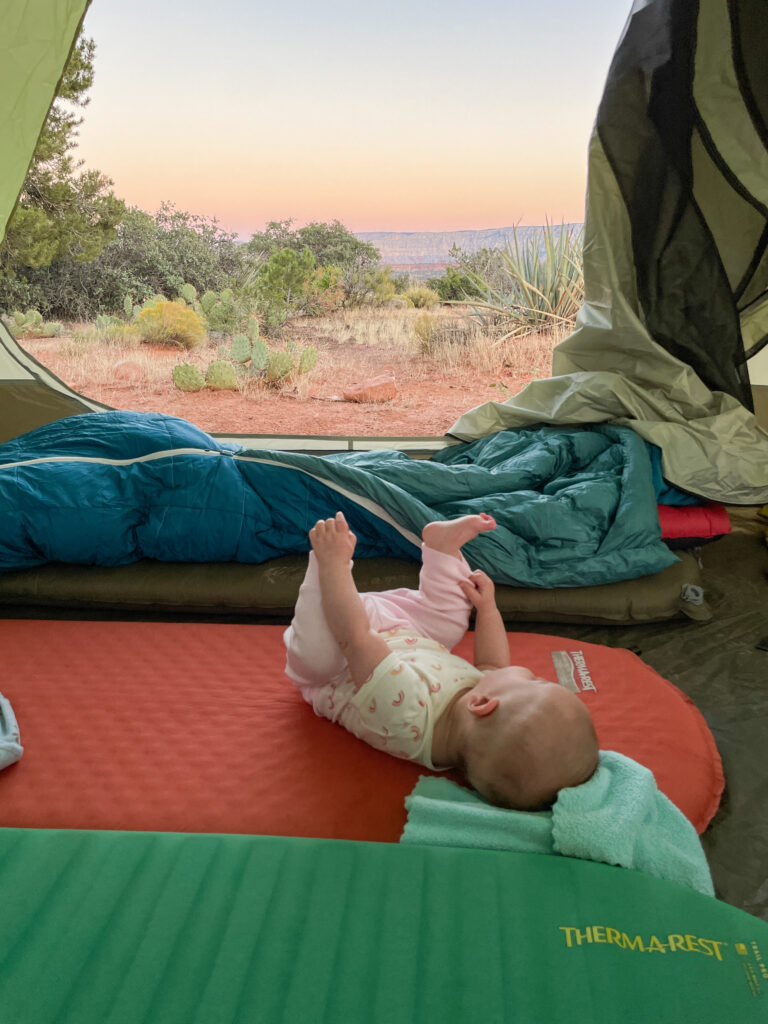
Camping with a Baby -
Incredible Tricks and Tips
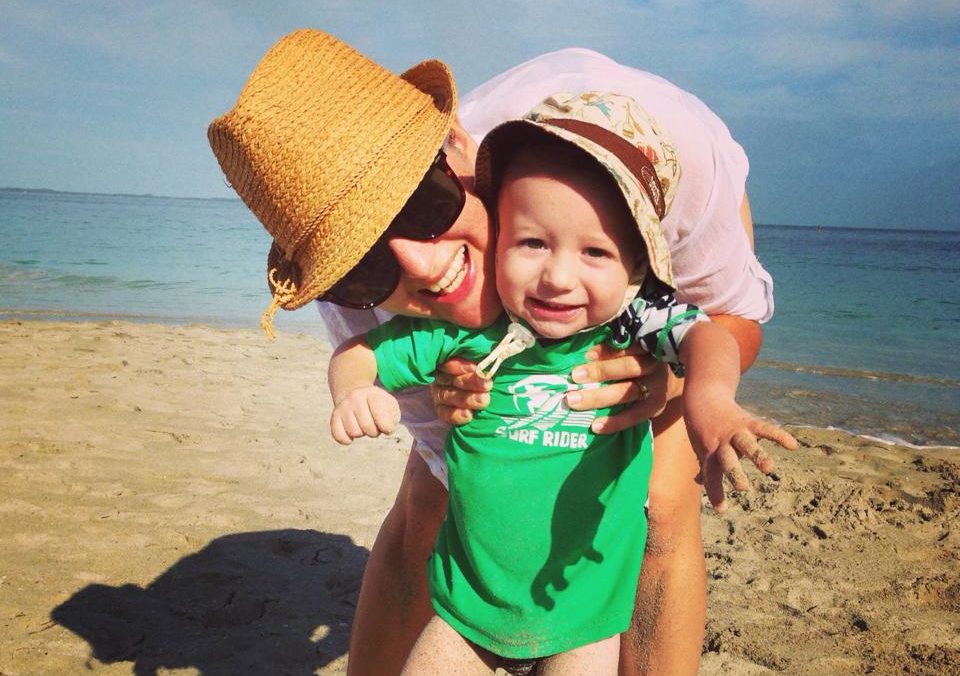
I feel like there are three categories of people: those who love camping, those who tolerate camping, and those who would rather shove a flaming hot s’more stick in their eyeball than voluntarily camp.
I’m a life-long lover of camping and I’m am trying to pass this love onto my three kids, even if camping with small children means I’m always yelling, “Don’t put that in your mouth!” My guess is that if you’re considering camping with a baby then maybe you already like doing it and, like me, you want to make it part of your family’s summer traditions. Yeah!
The first time I camped with a baby I was a very nervous Nelly, but it really wasn’t as hard as I thought it would be. Camping is kind of a pain in the ass and so is having a baby, so I didn’t really feel like it was that big of a deal, in the end. For the sake of this post, let’s assume you’re going car camping with your babe. That is, you’re packing up the car with supplies and driving up to your tent site. So what do you need to bring? What should you avoid? Pull up a folding chair, my friend. You’ve come to the right campfire.
General Packing for Camping with a Baby
Pack all the typical stuff you need for baby, but bring double. No, I’m not kidding. Bring extra diapers, wipes, food, and changes of clothes. I am constantly amazed by how quickly my kids get dirty and/or wet when we camp. And their appetites are voracious! (All that fresh air, right? It has the same effect on appetite for beer. I digress…)
Your baby’s life while camping will look remarkably similar to her life at home: play, sleep, and eat. So all you have to do is figure out a way to make all these things happen while in the great outdoors.
Here’s a detailed list of what you can bring camping with a Baby
You don’t have to bring it all – I just wanted to get stuff on your radar.
Play
Right off the bat, when you pull up to your campsite you’re going to want to unload and set up your tent and get everything unpacked. And then you will immediately realize there is nowhere to put your baby down because you’re in the forest and the ground is covered in rocks and sticks oh fuck, why am I here. Your baby needs a safe place to chill.
protection from the skeeters
Throwing your baby into a carrier is a great option, though I’m not sure how easily you’ll be able to set up a tent while front-carrying. If your baby is tiny you can just plop baby in his bucket car seat and put him wherever. Or, set up your Pack N’ Play and put an elastic sheet or mosquito net over the top to prevent bugs and leaves from getting into it.
Another great option that I tried when my son was crawling/pulling to stand but not yet walking was a baby yard on top of a tarp. I chucked a bunch of toys in there and he actually really enjoyed it! My husband called it “baby open-air prison” but hey, at least it provided one safe spot where I could let him crawl around without worrying he’d shove a rock in his mouth.
When I asked people on Facebook for advice, one mom suggested putting your crawling baby in an inflatable baby pool at the campsite with interlocking foam mat squares under the bottom to make it cushy. (The pool can double as a bathtub, too.)
Another reader put her son’s booster high chair seat into a collapsible wagon and pulled him around the campsite in that. Another suggestion was to bring a small separate tent, fill it with toys, and treat it as the “playroom”.
Sleep
OK, so you’re gonna need a tent. In my opinion, the bigger the better. Before we had kids my husband and I cozied up in a two-person tent. So romantic! Well, those days are gone and my family of 5 currently sleeps in a 10-person tent.
I like to be able to stand up in my tent so I can change my clothes easily and I like to be able to have everyone’s beds and duffel bags in the tent with us, as well as enough space to set up a diaper changing area, so that ends up being a lot of square footage. Having a huge tent also leaves plenty of space for baby’s pack n’ play next to your air mattress.
Note: Keep in mind that air mattresses are not considered safe by the AAP because they pose a suffocation risk from your baby rolling into an underinflated fold, or slipping between the mattress and something else (tent, another mattress, a bag of clothes, etc.) so shoot for a safer scenario if possible. Here’s a helpful post called Safe Sleep for Babies: Good, Better, Best that gives you some ideas.
One of my all time favorite tricks is taking a portable sound machine. It downs out noisy neighbors and adds a familiar sound from home.
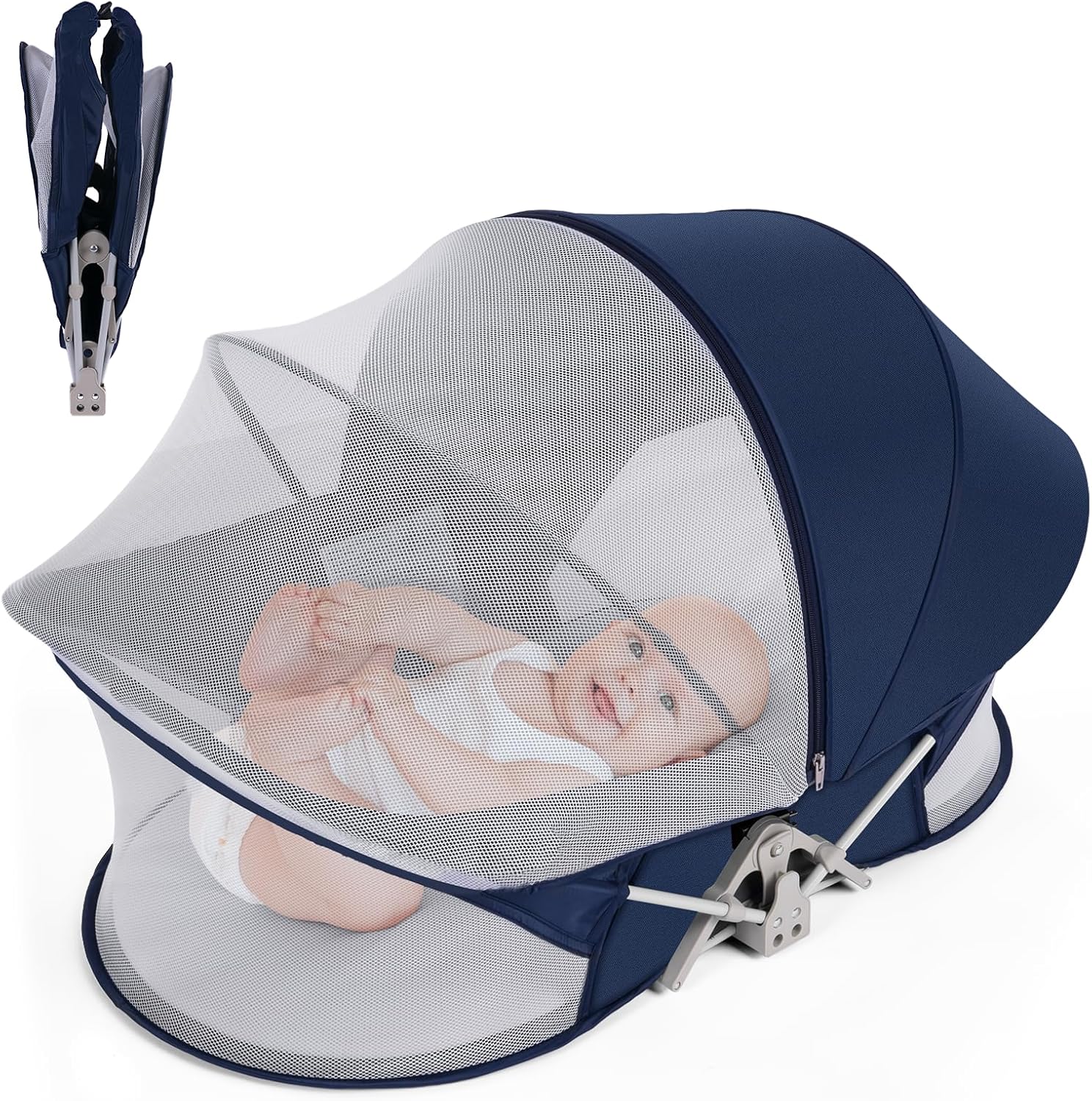
If you have a tiny, non-mobile baby and you don’t feel like lugging a huge pack n’ play on your trip, you can get a handy collapsible travel bassinet. (I used one of these on a camping trip with my 2 month-old and found it great for easily scooping baby up for nighttime feedings.)
Obviously, you can’t regulate the temperature in your tent so come prepared with baby’s warm PJs and socks, even for summer nights. If you know it’s gonna be really chilly you can get one of these baby deedee sleep nest sleeping bag sleep sacks. They are toasty warm and safe to sleep in.
Eating
If your baby is still on an all-liquid diet then your packing needs in this department are pretty straightforward: bring your boobs and/or bring a lot of formula and clean water. When I say ‘a lot’ I mean bring more than your baby typically eats so if something happens you have plenty of extra.
Cleaning bottles becomes a bit tricky in the woods. Check ahead of time if your campground has bathrooms with running water – many campground bathrooms have a special outdoor sink designated just for washing dishes. You can bring your own wash bin, soap, and sponge to wash out your bottles and then even boil them on your camp stove to sterilize if that’s your thang. Another option is to use disposable drop-ins while camping, but you’ll still need to clean the nipples.
If baby is sitting up and eating solids, I suggest bringing a vinyl tablecloth and a high chair seat thing that clamps onto your campsite’s picnic table, bring a travel high chair like this one or use a go pod activity seat.
Also, bring a camp chair that is comfortable for feedings. You don’t want to be stuck sitting bolt upright at the picnic table when it’s time to relax and feed baby.
Other Stuff for Camping with a Baby
Your baby carrier for hikes. I’ve used and loved my Kelty backpack for years. (Check the price on Amazon as well.)
Pack some of your gear in a big, plastic Rubbermaid bin and then use it as a makeshift baby tub (campground frequently only have showers in their bathroom facilities)
A few readers suggested Carhartt overalls because the knees can take a beating for babies crawling around over rough ground. It’s also easy to layer them on over another outfit and then peel them off again.
Rain pants came highly recommended for keeping kiddos dry.
Bug spray and sunscreen (you can check out our post on sun safety too.)
Really, I promise, camping can be so super fun! Even if your baby is up at 5 am, crawling around and eating sticks off the campground road. Ahem.
Have you taken babies camping?
What did you find helpful? Let us know in the comments!
DOWNLOAD THE CAMPING WITH A BABY CHECKLIST
Camping In the Desert
Camping In the Mountains Or A Park
Covered on PDF Booklet
More Adventures
With Babies
Tips for Boating With Babies + Baby Boating Accessories
PRO TIP: Introducing your baby to SUP (Stand-up Paddleboarding)
How I Got My Kids Out Flatwater Kayaking As Babies
Our Favorite Water Friendly Baby Carrierscan be used in and out of water.
Fishing with a Baby in Tow - FrostyFly
Canoeing with Babies – The Basics
Climbing (and Bouldering) with Babies and Toddlers
Hiking with a Baby - Baby Can Travel
Dealing With Diapers During an Adventure
Cross Country Skiing with Baby
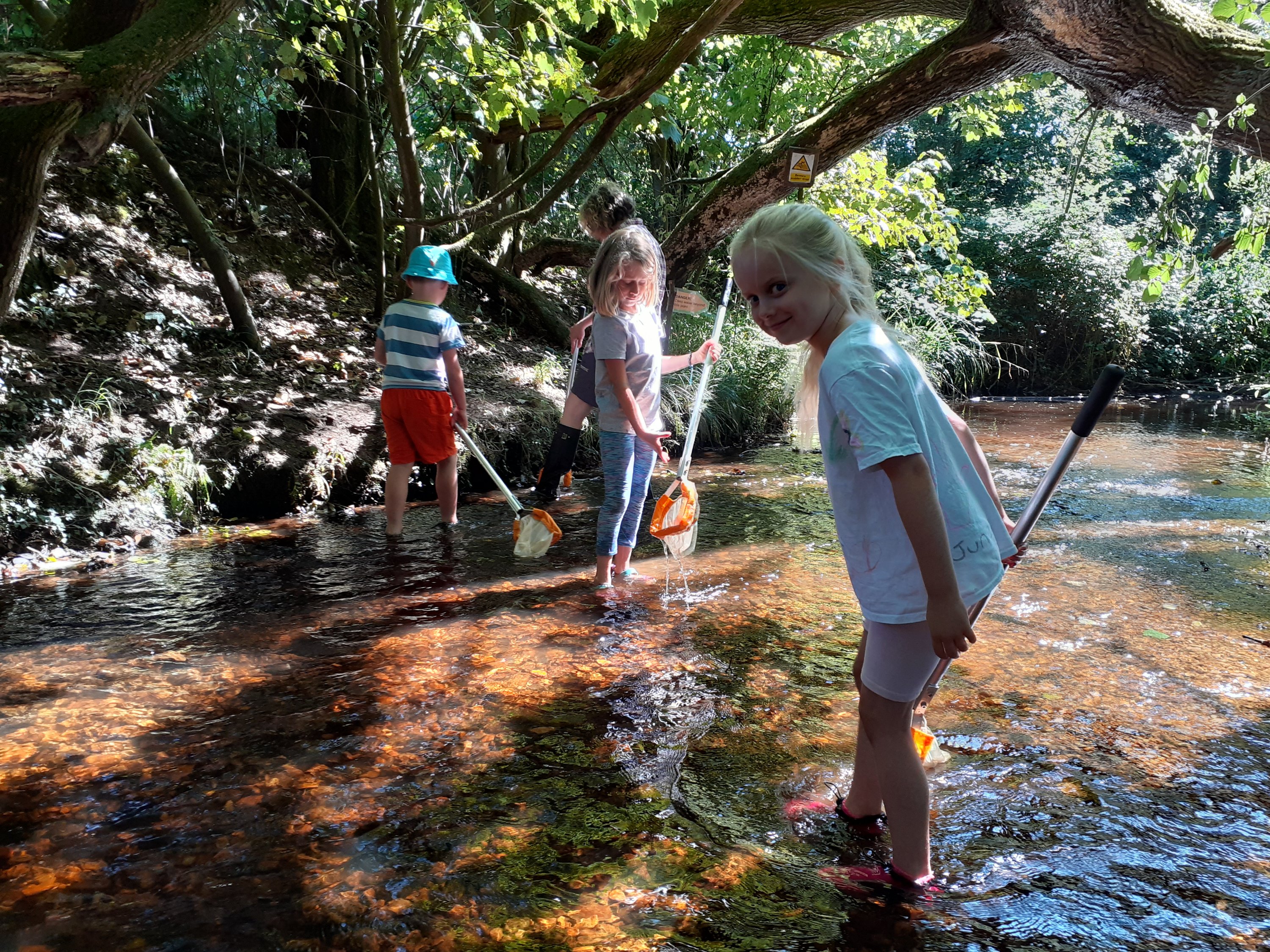
How to Take Your Baby on a River or Stream Exploration
Taking a tiny human floating seems intimidating, but it doesn’t have to be.
Every March, when we’re sick of winter but too impatient to wait for spring, my husband and I drive to the desert to go paddling. The rivers of the Colorado Plateau run muddy with snowmelt, and the sun feels like heaven. Weather on these trips is variable—we’ve been snowed, rained, and hailed on—but the quiet canyons and starry nights are worth the gamble.
This year, though, there was an even bigger variable: our daughter Josephine, who was 11 months old and had never been in a boat of any kind. How would she react to spending hours each day in a canoe or raft? Would she sleep when nighttime temperatures dropped into the thirties? And was it foolhardy to take her so deep into the wilderness that you couldn’t easily hike out?
Still, as the snow continued to fly at our home in Colorado, I couldn’t stop daydreaming of a 45-mile stretch of calm water that flows through Utah’s Labyrinth Canyon. I’d been reading Alan Kesselheim’s book Let Them Paddle, about canoeing with his children, and the fact that he’d taken an eight-month-old on a month-long expedition down the Yellowstone River made my idea seem tame. For additional inspiration, I reread a few chapters from Mardy Murie’s classic memoir Two in the Far North, in which she takes her six-month-old on a four-month Arctic river trip in the 1920s, long before GoreTex and disposable diapers. Clearly, I rationalized, humans have been taking babies down rivers for millennia.
Despite those two books, there’s relatively little information about how to pull off a multi-day river trip with a little one. Apart from a few tips I gleaned from Murie and Kesselheim, we were mostly winging it. As I made lists and packed meals and stuffed clothes into drybags, I was slightly terrified that the minute we were stuck in the bottom of a canyon with a wailing baby, we’d regret leaving the house.
There were indeed a few times when we were stuck in the bottom of a canyon with a wailing baby. But I never once regretted it. Here’s how we pulled it off.
Buy a Good PFD
One of the smartest things I did when pregnant was to use my baby shower to convince friends and family to buy me fancy outdoor baby gear, including this bomber PFD from Level Six. This one is comfortable, doesn’t ride up, and will fit for several years. I also made my daughter wear it around the house for a couple weeks so that she was used to it before we got on the water.
Choose Your Destination and boat Wisely
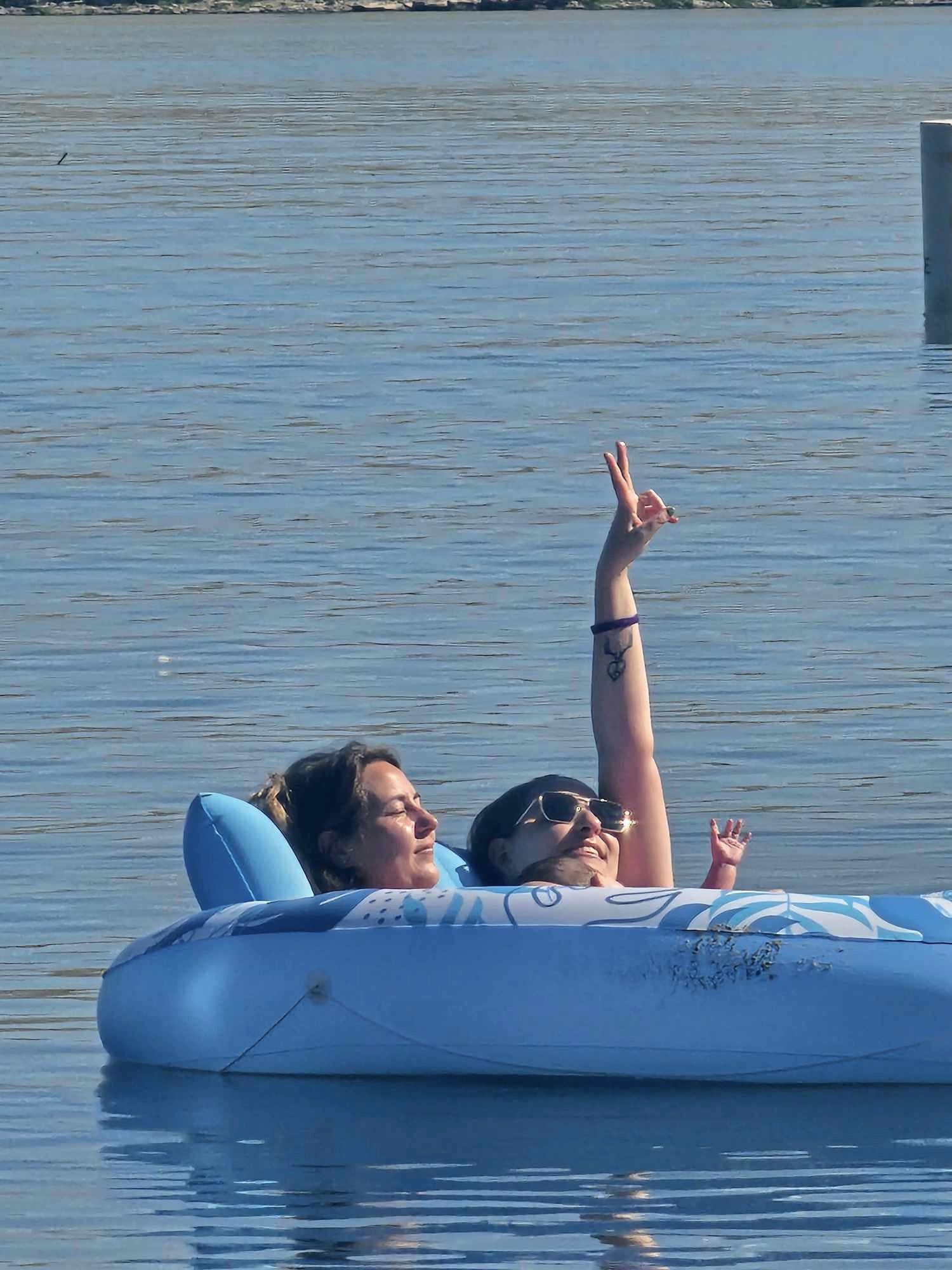
First, your destination: You want water with easyrapids (Class I) or none at all, in an environment where you’re already comfortable with backcountry travel. Then, choose your craft. Kayaks are not practical with a baby. Rafts can haul lots of gear and people but are slow, heavy, and often have standing water on the floor, which means no dry place for an infant to hang out other than in your arms. Canoes, on the other hand, are practically made for babies. The gunwales are the perfect height for a standing baby to hold onto, the hull stays mostly dry and offers a solid surface for playing or napping on, and they’re easy enough for one person to paddle if the other needs to hold or feed the kiddo.
Learn to Paddle A Canoe
Any sport that requires two people to operate a single machine—like tandem bicycling or canoeing—is a fight waiting to happen if you don’t know what you’re doing. Before you push off with a baby on board, get on a local lake or river and practice paddling with your partner. Master the J-stroke, reverse stroke, and pry and draw, or consider taking an introductory course from an organization like the American Canoe Association. Once you get into the backcountry, there will be plenty of things to stress over; your J-stroke doesn’t have to be one of them.
Give Yourself Extra Time
We spent five days covering just 45 miles (it's a two- or three-night trip for adults). That allowed for a layover day if the weather turned and gave us shorter days on the water, spread out over more time. It was tempting to try to do the trip in as few nights as possible to simplify the logistics, but I’m glad we didn’t. It took a few days to get into the groove of loading the boat each morning, paddling all day with the baby, and setting up camp in the evening, and we wouldn’t have wanted to be getting off the river just as we were hitting our stride.
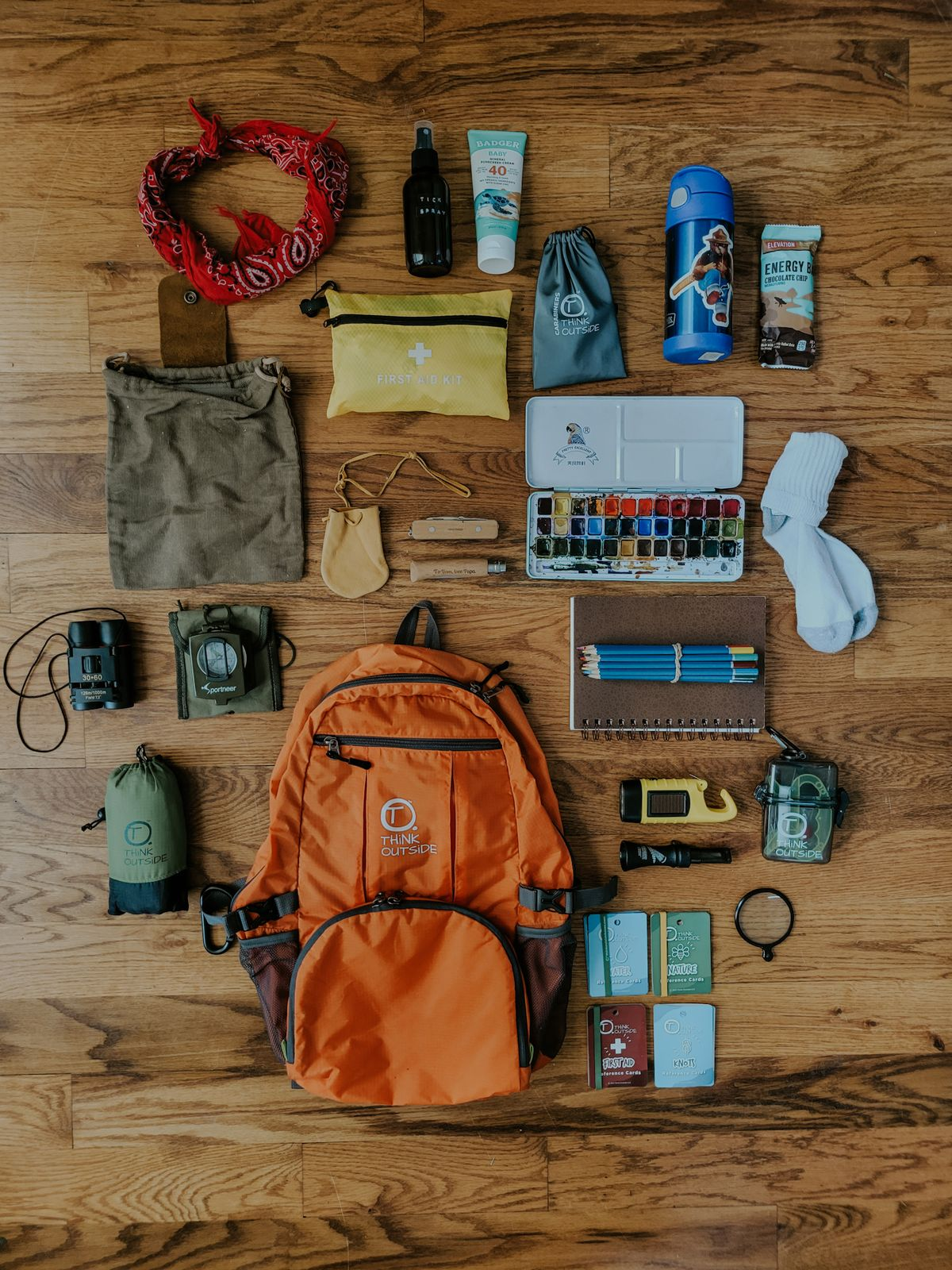
Pack a Day Bag
When you push off from shore, most of your gear will be hard to access, crammed into drybags and tied to the boat. Make sure you have the essentials in one easy-to-access spot. For us, this meant a 30-liter SealLine Baja drybag that I stashed under my seat, packed with a warm hat and jacket, sunscreen, snacks, diapers, wipes, and a blanket.
Camp and Survival Bag List HERE
DOWNLOAD THE BABY ADVENTURE CHECKLIST
Ditch the Cotton Onesies
Sometimes when I dress my infant in her synthetic Patagonia base layers I feel ultra snooty, even though I got them used from the company’s Worn Wear site. On this trip, though, they proved ten thousand times better than cotton onesies: breathable but warm, quick drying, and so durable that Josephine wore them every day on sand and mud and abrasive rocks with no discernible effect.
Take a Rescue Beacon
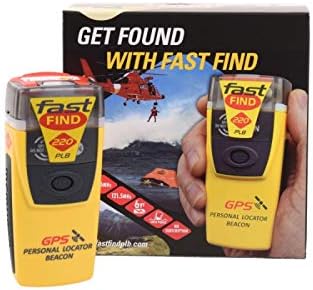
Emergency beacons—like a SPOT Satellite Messenger or Garmin InReach—let you to call for help from remote areas with no cell coverage. They’re also not cheap. The Garmin costs $400, and the SPOT is $150 plus an annual or monthly subscriptions. But if I was ever in a sticky backcountry situation with an infant, I’d kick myself if I hadn’t invested in technology to activate a rescue with the push of a button.
Bring an Old Sleeping Pad or Car Seat
I had no faith whatsoever that Jo would nap in the canoe; she’s a fussy sleeper who struggles to drift off. But something about the quiet and the rocking motion lulled her right to sleep. I laid her on an old half-inflated Thermarest in the bow, draped a lightweight blanket over the gunwales for sun protection, and paddled in total bliss while she dozed.
For younger babies, we heard of parents who brought a car seat, put an umbrella over it, and let the baby snooze or hang out there while the parents paddled. If you go this route, make sure not to strap your child into the car seat. That way, if you accidentally flip the boat, your baby isn’t buckled to a heavy object that will sink.
Rock the Boat
The best advice we got was to bring a plastic bucket and fill it with rocks every morning. Apparently every baby on earth gets a kick out of throwing stones into the water from a canoe, keeping them distracted so you can paddle. On shore, too, they made the best play things. I brought a couple toys just in case, but Jo was way more interested in the local geology.
Without hesitation, I can say that our springtime journey through Labyrinth Canyon was the best river trip of my life. Not because of the water or the scenery, which were both plenty nice, but because I got to watch Jo discover the joy of traveling by canoe, tossing rocks overboard and watching the world go by.
Sensory Rich
Shore Play
This post is all about turning a visit to your local stream into a sensory experience for the kids. Creeks and streams are full of amazing opportunities for kids to get immersed (literally!) in nature. Playing in or near a stream is not only a learning experience about the natural world around them, but it’s also a chance for kids to get wet, muddy and have a lot of fun! We’ve already covered all the amazing benefits of letting your kids play in the creek. Today, we have Brooke Selb from wreckingroutine.com sharing the benefits of streamside sensory play and how her family enjoys their local creeks and streams.
Trading the hikes for a stream
With two kids under the age of three, our days of hiking double-digit trails on a Saturday morning are no longer realistic. While our kids do pretty well on the trail, we are capping out around three miles. In fact, during our spring break staycation, we hiked two miles in mildly windy weather and both kids cried the entire time! Not the relaxing hike we envisioned.
However, both my kids (Zoey and William) absolutely adore sensory bins of any kind (think rice, beans, dried pasta, and shaving cream). They also love being outdoors (just like their mom and dad). So, we combined those two things into something fun and took the arduous hikes out of our routine.
Streamside sensory play
Streamside sensory play is the perfect activity to get us all outdoors. We get to discover more about our surroundings, learn about local nature, and get messy. When I first realized how much Zoey loved this type of play, we ended up venturing out to our nearby streams at least once a week. Now that the weather is warming up, we are back to it! Our girl could not be happier to share her love of outdoors and water with her younger brother.
How to choose a good spot
I have found a few spots near our house in Colorado that are perfect for streamside sensory play.
Some things that I look for in a good location are:
A flat and level area next to the stream. This prevents the kids from having to reach down into the water from slanted ground, which can lead to falls. We also look for flat areas so we can put out a blanket for William to sit on or as a place to rest and have a snack.
Location with a variety of textures. We like areas where the kids can get wet and muddy, with rocks or trees nearby. Gathering rocks and sticks to use in the water is all part of the fun!
Slow running water. I like the water to have a little movement. Not only does it help keep the bugs away, but it ensures that the water is not stagnant or smelly. Although, do not choose a spot with too much movement because when the toys inevitably slip out of wet hands, you want to be able to snag them before they get downstream too quickly.
Shallow water. The kids love getting in the water as much as possible, so shallow water helps me ensure they’re safe.
How to play streamside
This is the best part…there are no rules! Just let them at it! Zoey is good at digging, scooping, and dumping. There is no end to what you can do waterside: putting pebbles in buckets, making mud pies, building sand castles, splashing in the water with her animal figurines, chasing/catching minnows, and changing colors of dry rocks once they get wet.
Getting wet is a must in the hot months and playing in a stream is a great way to cool off and immerse yourself in nature. Playing in the stream allows all your senses to be stimulated. From the smell of the surrounding woods, to the cool touch of the water and the sound of the babbling stream. I let Zoey take off her shoes and socks and squish her toes around in the mud. She giggles the whole time!
What to bring to the stream
Another good thing about playing in the stream is that you don’t need any fancy gear or equipment. Mainly, all you need is your imagination and a sense of adventure! However, there are a few things I’d recommend you bring along for your streamside outing:
A change of clothes. The most fun part of streamside sensory play is that the kids can get as wet, muddy, and generally messy as they want. While I try to time trips to the stream with bath night, a change of clothes will at least get you home with dry, happy children.
A hat. While some of the streams might be shady, often times the best spots for sensory play are in the open. Protect those little heads from that bright sun with a hat and/or sunscreen.
A sand toy set. Buckets, shovels, rakes, spoons, cups, toothbrushes all make excellent streamside toys. Essentially, anything that allows them to dig in the mud and scoop water. I’ve even brought a paintbrush along to make mud pictures on the concrete or rocky areas.
Animal figurines. We bought a cheap pack of little farm animals from the dollar store and Zoey adores playing with them in the stream. She builds muddy hole homes for them, dips them in the water to clean them, and hides them in the grass or under little rocks. They certainly add an extra element of fun.
A towel. Be prepared for muddy feet and wet hands! It is also nice to be able to dry off hands before the all-important snack break.
Blocks-Blocks can go anywhere and babies love to have something familiar to play with when playing in a new environment.
Snacks. This should be a given because if we are being real, we never leave the house for any activity without a cache of snacks. There’s something about fresh air seems to make the kids extra hungry.
Let Them Play & Explore
The essential part of streamside sensory play is to really let the kids discover with all of their senses (except maybe taste, because…mud). They will get wet, muddy, and just overall dirty. Let them do it! They’re making memories! I promise they will talk about that time they were allowed to get as muddy as they wanted for years to come.
Superscript
Discovering Lakes
& Beaches With Baby
A warning for hot beach sand is crucial.
When air temperatures are above 75-80°F, as sand can reach dangerous temperatures (over 110-120°F) in minutes, enough to cause serious burns on skin and paw pads. To stay safe, check the sand's heat by placing your hand on it before walking, wear protective footwear, seek shade, and avoid the hottest parts of the day. Pets, babies and young children are particularly vulnerable. Use protective gear or barrier mats between baby and sand at all times.
Why Sand Gets Hot
Low Specific Heat:.Sand requires less energy than water to heat up, allowing it to absorb sunlight and get hot quickly.
High Density:.Sand's high density allows it to store large amounts of heat, which it holds for a long time.
How Hot Can Sand Get?

When the air is 75°F, sand can reach over 100°F.
At 90°F air temperature, sand can be over 120°F.
At 85°F air temperature, sand can reach 125-140°F.
Safety Precautions
Test the Sand: Before walking, place your hand on the sand. If you can't hold it comfortably for five seconds, it's too hot for bare feet.
Wear Shoes: Wear footwear with rubber, plastic, or foam soles to protect your feet.
Seek Shade: Use beach umbrellas to create shady areas and avoid prolonged exposure to the hot surface.
Time Your Visit: Go to the beach earlier in the morning or later in the evening to avoid the hottest parts of the day.
Protect Pets: If the sand is too hot for your hand, it is too hot for your dog's paws. Carry them or wait for cooler times.
Burn Symptoms
Redness, pain, and blisters on the skin are signs of a sand burn.
Symptoms can appear quickly, with burns possible after only a few minutes of contact with hot sand.
My Daughter sharing her love of the water with her baby with an approved infant floatation device -From Amazon.
Sky loved it and she could be in the water with her favorite people.
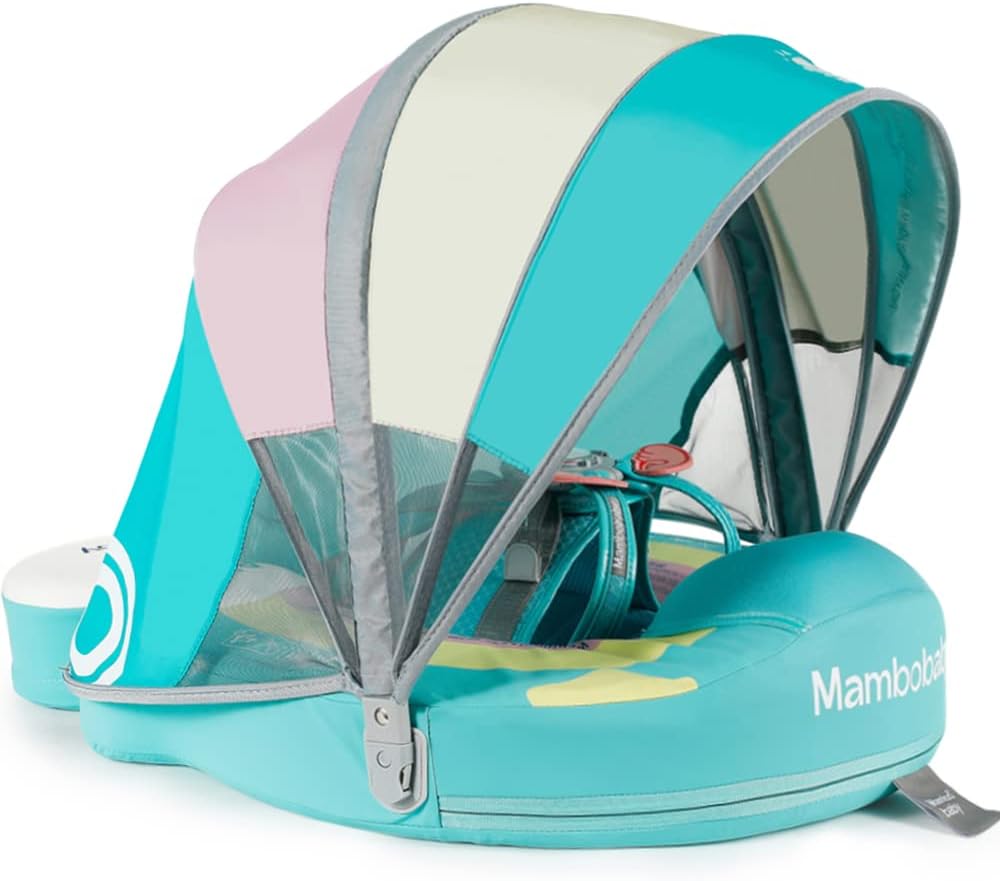
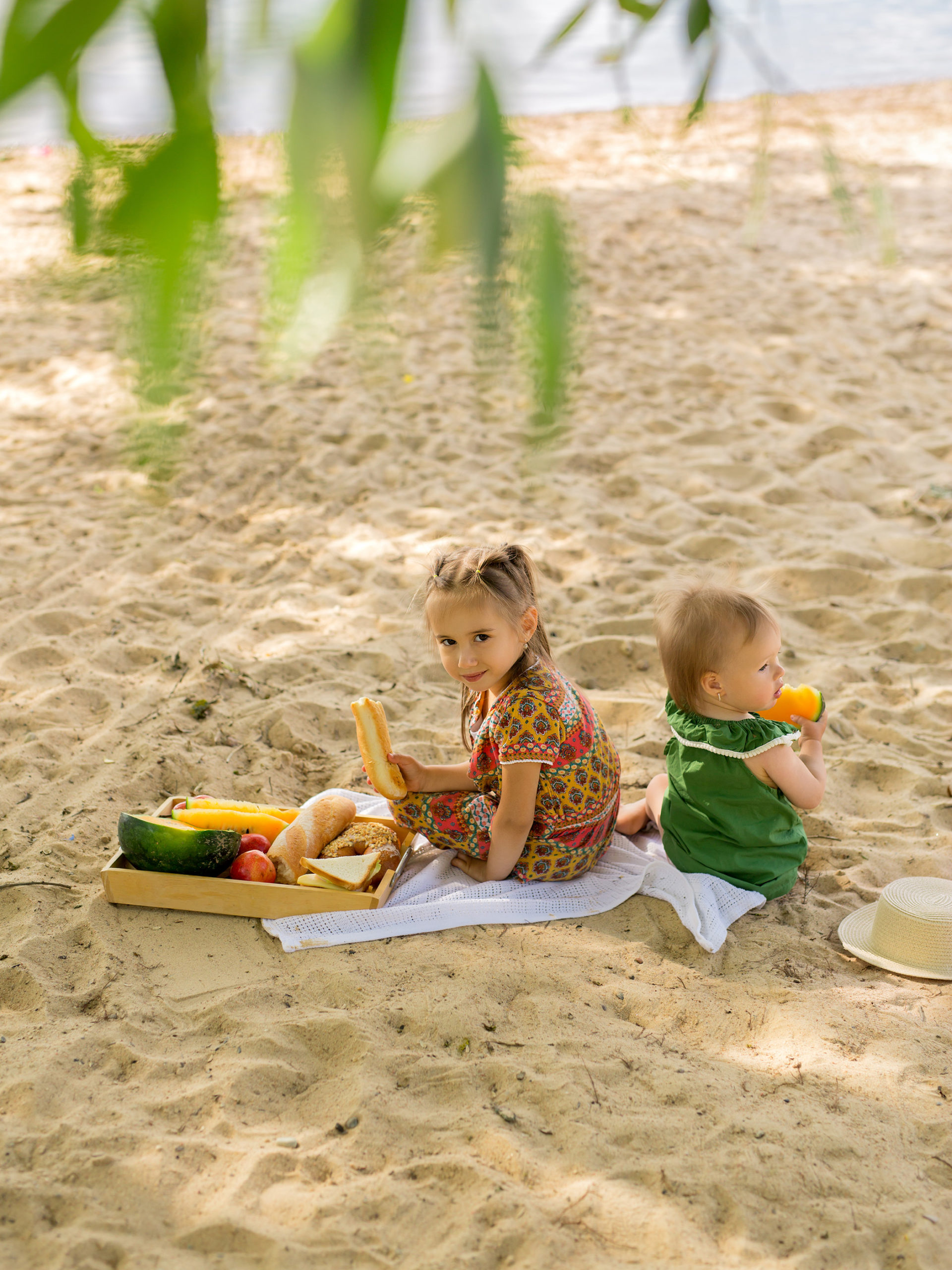
Being Fascinated with Fun at the Lake or Pond
My kids are fascinated with nature because I am fascinated with nature. Even things that may seem mundane to me at this point in my life will probably be new and exciting for kids. That is why I practice child-focused exploration and make sure to get excited about whatever they want to explore and discover. When I get really into the activity, it acts as the match to spark curiosity and adventure in my kids. So, get pumped! Yes, even if you don’t feel it. If you want your kids to have this connection to nature you must demonstrate it yourself.
That being said, I need to give parents a tip. Playing in the lake, kids will get wet and most likely dirty. Be prepared with towels and either wear waterproof clothes or bring a change. Water shoes are also recommended if you don’t know the lake. Our Favorite Water Friendly Baby Carrierscan be used in and out of water.
How To Have A Safe Lake or River Trip With Your Baby
Table of Contents
Purchase an infant PFD (personal floatation device)
Safeguard against dehydration
Avoid Peak Sun Exposure
Find a location with shade
Protect their skin when in the sun
Protect their eyes
How to purchase an infant PFD (personal floatation device)
A popular lake day activity is boating. While babies are able to board, they too must follow the state laws. Most states require that everyone on board have a PFD. The Stingray Infant PFD is a great choice because it is US coast guard approved and uses bright colors so your baby is easily visible. In addition to these necessary features, this life jacket is made from a durable and quick-drying Nylon fabric with quick-release buckles.
Even if you don’t have plans to boat, it’s best for a baby to wear a PFD anytime they are in the water.
Lifejackets- Babies under 35 pounds are not big enough for a baby lifejacket. They can die from suffocation when they slip inside the lifepreserver without you knowing.
Safeguard against dehydration
During a hot day, it’s easy for adults to dehydrate quickly. This is even more true with infants. Come prepared with extra bottles or plan to nurse more frequently if currently breastfeeding. If your baby has reached the age where they can start eating solids, consider bringing a couple of servings of food that are travel-friendly. A great example of this is fruit/veggie pouches.
Avoid Peak Sun Exposure
A lake day might look a little different with an infant because of the fact that you’ll want to avoid peak sun exposure. These hours generally fall between 11 a.m. and 4 p.m. Getting an early or late start to the day might also be a great way to beat the crowds! If you can’t avoid these harsh, daylight hours, read below for some additional tips.
Find a location with shade (or take shade tents)
One of the first things you’ll want to do when getting to the lake is finding a great spot with plenty of shade. No sunbathing for the baby! In addition to finding natural shade given by trees, feel free to bring a sun canopy or umbrella that has UPF protection. Trust us, keeping cool not only protects their delicate skin, but it will help with their mood!
Protect their skin when in the sun
You probably don’t want to hide out in the shade all day at the lake. This is when you need to be especially careful about sun exposure. The US FDA recommends avoiding sunscreen for infants that are under the age of 6 months. Choose UPF clothing that covers them as much as possible. In addition, always keep a sun hat on your baby that protects not only the tops of their heads but the back of the neck and ears.
Protect their eyes
While baby sunglasses don’t seem to be the most practical item to bring to the lake, they can be very helpful! Recent reports have suggested that babies’ eyes lack the ability to block UV rays to the same degree that grown adults can. These may be foreign for a baby to wear so practice several days before getting your baby used to feeling them on.
Wind Direction Watcher
Build this wind direction watcher and you'll be able to see the wind blow!
What You'll Need:
Piece of cardboard
Marker
Tape
Small mirror
Compass
Swoooosh! There goes the wind ... and now you can see it!
Step 1: Mark out north, south, east, and west on the outside edge of a piece of cardboard. Include other directions, like northeast, if you like.
Step 2: Tape a small mirror to the cardboard so that the compass directions form a circle around the mirror. Now you're ready to chase the wind!
Step 3: Place your cloud chaser on the ground so it faces north. You can do this by matching north on your cloud chaser with north on your compass.
Step 4: Lie next to your cloud chaser and watch the reflection of the clouds in the mirror. Once you see which way the clouds are moving, you'll know that's the same direction that the wind is blowing.The next activity is sure to give your imagination a workout
Taking Baby to the Lake Tips
There are few things better than going to the lake on a nice sunny day. In most cases, you don’t have to deal with the traffic at the beach and there’s usually a lot more shade provided by trees planted in the grass. The lake is a great place to make memories that will last a lifetime and you don’t have to wait until your baby is older. As long as you take the necessary precautions, taking baby to the lake is something you can do throughout the year. However, depending on where you live in the world, you’ll probably want to wait until the summer months. The lake is a lot more enjoyable when the sun is shining.
Whether you have found a lake while on vacation or there’s one in your city, you might as well take time to enjoy the beauty of nature. Below are tips for taking baby to the lake that will make the experience fun and safe.
1. Avoid Peak Sun Exposure
Going to the lake is obviously something that you’ll want to do during daylight hours. As with many other outdoor activities, it’s best to engage in them when the sun is shining and the birds are singing. When taking your baby to the lake, you’ll want to avoid peak sun exposure, which is during the timeframe of 10 a.m. and 4 p.m. This is when the UV rays of the sun is at it’s peak. If you don’t want to go before 10 a.m., you can certainly have a great time after 4 p.m., especially during daylight savings time when the sun sets later in the day. It also happens to be a great time of day to take family pictures.
2. Find a Location with Shade
When taking baby to the lake, one of the first things you’ll want to do when you arrive is to find a location where there is plenty of shade. Since it’s a lake, there are likely to be a number of trees in the area. The shade of a tree is a great way to combat exposure to UV rays. While you can certainly take other precautions, this is an added bonus. Shade can also keep everyone a lot cooler. There’s no doubt about the fact that sometimes it’s just too hot outside to feel comfortable. When you find shade, your outdoor experience will be a lot more enjoyable.
3. Be Sure to Cover Up
A priority when taking baby to the lake is being sure to cover up. A baby’s skin must be protected from the sun and one of the best ways to do this is by choosing articles of clothing that are lightweight, yet still protect the skin. While there are some days when it’s too hot to wear a lot of clothing, it’s still a good idea to wear lightweight clothes for sun protection. The good news is that there are a lot of fashion choices for babies that can help with covering up. In addition to lightweight clothes, you can use little bonnets and hats to protect your babies face. You’ll be able to take adorable pictures because babies look so cute in hats.
4. Bring Baby Sunglasses
Studies have shown that a baby’s eyes do not have the ability to block UV rays to the degree that adult eyes can. Fortunately, there are baby sunglasses on the market that you can buy for your trip to the lake. Most people use baby sunglasses because they look so cute. While they are likely to be a topic of conversation, baby sunglasses are also functional and a great form of protection when taking baby to the lake.
5. Provide Plenty of Water
If you’re like most people, you probably drink plenty of water throughout the day. If so, it’s not just a habit, it’s a necessity. The same applies when taking baby to the lake. Just like you need to drink water to ensure you’re hydrated, your baby needs water too. When you’re at the lake, it’s a good idea to ensure everyone there drinks water to stay hydrated. If you’re still breastfeeding, that can help to keep your baby hydrated, but that doesn’t mean there isn’t still a need for water. To make it easy to stay hydrated, try drinking water every hour. In addition to preventing dehydration, you’ll feel better, especially if you bring cold water and keep it in the cooler during your trip to the lake.
6. Choose a Lightweight Baby Carrier
There are all kinds of baby carriers on the market. Some are bulky and sturdy, while others are more lightweight, but still effective. When taking baby to the lake, you’ll need a lightweight carrier that’s breathable and circulates air effectively. This is for the comfort of you and the baby, especially during the summer months. If you decide to take your baby to the lake during the spring or when it’s not as hot outdoors, you can use a standard carrier. Don’t forget to choose one that’s also ergonomic.
7. Don’t Forget the Sunscreen
Without a doubt, one of the most important things you’ll need to remember when taking baby to the lake is the sunscreen. Sometimes it’s easy to think that only adults need sunscreen, but that is definitely not the case. It’s generally recommended that you choose an SPF that’s a minimum of 30 to protect your baby’s skin. Adults often spend time in the sun because they want to get a good suntan. Your baby obviously doesn’t need a suntan, so you’ll want to take every precaution to keep your baby’s skin protected.
8. Be Flexible
When planning time for taking baby to the lake, you’ll want to schedule the trip, but maintain flexibility. This is because anything can happen with the weather, even during warm months. While it might seem like a good day, bad weather can make a trip to the lake a disaster. You might as well avoid as many difficulties as possible by monitoring the weather to ensure it’s the best time to go. If there’s a chance of rain, you should plan your trip for another day. You’ll also need to be flexible about the activities at the lake because you don’t want to do anything that could put your baby in harm’s way. Time at the lake should be an enjoyable and relaxing experience with your baby and other family members.
9. Pack a Blanket
While taking baby to the lake can be a lot of fun, you have to be prepared to make your time there comfortable. By packing a blanket, you can create a comfortable space where you can lay your baby down for a few minutes or let your baby crawl around without getting on the grass. While there’s nothing wrong with your baby spending time on the grass, the blanket is better because you won’t’ have to worry about as many pests, like ants. A blanket is also great because you can have a picnic on it. Just don’t forget to fill the picnic basket with all of your favorite summer fruit.
10. Prepare For An Emergency
An emergency can occur when taking baby to the lake, so make sure you’re prepared. Just like anywhere else you decide to go, it’s a good idea to pack supplies for emergencies. This might include ice, bandages, disinfectant wipes, and anything else that you would typically find in a first aid kit for children. You might also want to include medication if you plan to be away for a long period of time. It’s possible to spend hours at the lake if you take plenty of food with you.
11. Bring a Few Toys
Since your time at the lake is probably for the purpose of having a good time, one thing you’ll want to bring is a few toys. Most babies will enjoy playing with a toy regardless of the location. You can choose to bring the toys that you know your baby will enjoy. In fact, you can also bring books so that you can spend time reading to your baby at the lake.
12. Choose Swim Diapers
Although taking baby to the lake might not involve going into the water, there’s a chance that you might decide to do so. If that happens, you should make sure your baby is wearing swim diapers. The last thing you’ll want to do is use regular diapers because your baby can end up being uncomfortable. If you know for sure that you can’t go into the lake water due to issues with possible contamination, there’s another option. You can bring a baby pool instead. A baby pool can be great because it doesn’t require a lot of water and your baby can enjoy time outdoors in water on a beautiful day. You can fill up the pool at the lake or bring water since a true baby pool is very small.
These are all ways that you can maximize the enjoyment of your time at the lake with your baby.
Lakes are a fascinating place, an ecosystem in their own right. They sustain entire life cycles of plants and animals in their own space. In the summer they hum with life, providing a vibrant atmosphere to explore. From the birds and insects filling the air with song to the fish flashing by in the water and the bullfrogs calling just out of reach, they are a child’s paradise of discoveries.
Exploring lakes with kids is also timelessly interesting, entertaining, and relaxing. Most children can find an endless number of interesting occupations at a lake. I can never believe how long my kids will spend just tossing rocks or sticks into the water. And I’m amazed at how beneficial that simple activity is: building strength and developing motor skills, making them aware of cause and effect, and introducing them to basic physics (gravity and displacement, for instance). Today, we will look at just a few ways you can experience a lake with your children, weaving education and development together with delightful play.
A note on lake safety
Before we get started, I’d like to mention some safety guidelines. Any time water is involved, we have to be extra conscious of our children’s safety. Water is such a fun thing that few children understand its danger. And unlike swimming beaches, lakes often have slippery mud or grassy banks that can drop abruptly into deep water. Teaching children to swim is the number-one prevention to drowning accidents, but even that isn’t a guarantee of safety.
Be safe together!
If you are comfortable allowing your children to wade in the water, make sure you have carefully checked out the wading area yourself for dangers like slippery mud and sharp drop-offs. And even if you have instructed your children to stay out of the lake, we should be aware that accidents happen and a child can slip and fall into the water in an instant. Stay close and focused on your children, adventuring and playing together. Exploring lakes with kids should be fun and safe.
Teaching nature skills
To start off exploring a lake with kids, simply walk around the lake or the area that you will be in. Talk before you start about how everyone needs to use their “nature skills” to explore the lake area. These skills include walking quietly, speaking quietly, and trying not to disturb the wildlife around you. We always have to work on sharing our discoveries quietly—the first child to yell they saw a goose will probably scare off the whole flock! This is also a good time to teach children how to study nature without disturbing it, to observe but not take, and to show respect for the natural environment surrounding them by being careful where they step and what they touch.
Sensory exploration
Exploring a lake with kids provides a great sensory experience. It’s easy to get started by asking questions involving the senses. What do you see? It’s like an amazing game of “I Spy.” Do you see those wildflowers on the far bank? Can you spot that turtle out sunning on a log? How many frogs can you count? Oh, no, one just ducked underwater!
Hearing and Smelling
Observing the natural atmosphere of the lake moves quickly to hearing. Do you hear the birds singing? The bullfrogs calling? The wind whispering through the tall grass? The buzzing of the insects? And then there is always smelling—and if the lake you are visiting has the smell of stagnant water, your children are sure to notice it! But you can also smell wildflowers and a fresh breeze. Honeysuckle and freshly cut grass. I love how much my children will get into talking about all the details they notice.
Unforgettable sensory experiences
When exploring lakes with kids, there are countless ways to experience the natural world. How many things can you find to touch? From the smooth leaves and raspy blossom of the cattails, to the silky water and slippery plants in the lake, to the slimy skin of a frog and the soft whisper of a dropped bird feather, there are a multitude of things to feel around a lake. (Of course, unless you have the owner’s permission to pick things, make sure you give careful instruction about not picking any plants or disturbing the environment. Leave it unspoiled for everyone to enjoy!) Touching lake creatures might stretch the sensory comfort zones of some kids, but if you have the opportunity to let your children touch a frog or a fish, it will be a sensory experience they won’t forget!
Resources
We have found that nature guides and handbooks are valuable resources for learning about aqua life. Teaching older kids to look up different plants and wildlife that they see helps them learn on a deeper level. Once they have looked up a bird or a flower in their guide book, they are much less likely to forget its name or characteristics! Plus, we can learn together all the things I don’t know (which are many!). We use some of the classic field guides, like Kauffman Field Guide to Birds of North America.
There are also some great resources available for less than $10, like these illustrated nature guides. The entire Take-Along Guides series is geared toward helping children learn about nature in an easy-to-find, graspable format. I can’t recommend them enough if you are serious about helping your children learn about wildlife and plants for themselves.
Hands-on Adventures for Exploration
Getting wet and dirty is part of learning about the lake environment, too. If my children are within reaching-distance of water—any water—they are sure to get wet! It doesn’t matter the temperature or what they’re wearing. If we are going near water, I just plan on them getting soaked.
Let Your Baby Explore!!!
When you take baby to the lake or a river, you have to let them explore everything in nature. While the water should be the central focal point and goal of the adventure, there are many opportunities to familiarize your baby with nature before you get there.
Letting baby feel the water and seaweed, pinecones, acorns, tree bark, leaves, and smooth river rocks are all part of the experience. Since babies are not cognizant about what they are feeling and unable to articulate it into words or ideas, they function at a more sensory level.
The fragrant smell of cedar firewood, the hickory of a barbeque, and the fragrance of flowers can all be a treat to your baby’s senses. And they will also enjoy the sounds of the rushing waters, the birds chirping, and other critters.
So, if the lake you are visiting is wading accessible, wear some water-appropriate clothes and footwear. Bring some buckets, a net, a magnifying glass, and explore a lake with kids up close if they have older babies!
What do you need to pack for a successful family day trip to the lake?
Here are the essentials, with a few tips for where to buy them (or download the printable below).
Swimsuits & rash guards
Dry change of clothes
Towels
Sunscreen
Sunglasses
Hats
Coast-guard certified life jackets (we like the Puddle Jumper for swimming but a traditional toddler life jacket with a head up float feature may be safer for boating)
Swim goggles or masks
Floats, inner tubes, & noodles
Sand toys
Snacks & food
Camera
Swim diapers (for babies & toddlers)
Bug spray
Drinks (especially bottled water)
Cooler & ice
Paper towels
Wipes
Trash bags
First aid kit
Ziploc bags (put dry items in them to protect against splashes!)
Swiss army knife
Flip flops and/or water shoes
Flashlight & batteries (this floating waterproof flashlight is an inexpensive choice)
Fishing supplies & license
Cell phone waterproof sleeve (we swear by this one for our iPhones, even while taking photos underwater!)
Cooking utensils or supplies if needed (plates, serving spoons, knife, cutting board, grill and related supplies like matches, charcoal/propane, tongs, aluminum foil)
More Adventures
With Babies
Tips for Boating With Babies + Baby Boating Accessories
PRO TIP: Introducing your baby to SUP (Stand-up Paddleboarding)
How I Got My Kids Out Flatwater Kayaking As Babies
Our Favorite Water Friendly Baby Carrierscan be used in and out of water.
Fishing with a Baby in Tow - FrostyFly
Canoeing with Babies – The Basics
Climbing (and Bouldering) with Babies and Toddlers
Hiking with a Baby - Baby Can Travel
Dealing With Diapers During an Adventure
MORE WATERPLAY
Covered in this Family Adventure Booklet
Sensory Summer -Waterplay Booklet
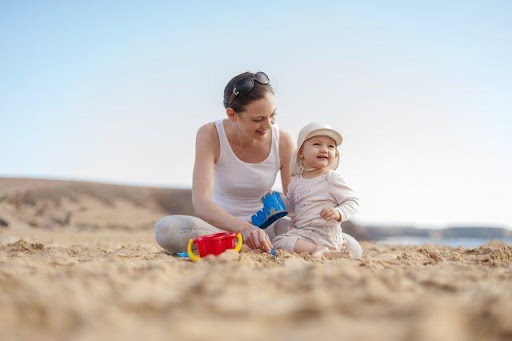
Baby Adventures For The Beach
Our Collection of Water Play Ideas and Tips
-All Kinds of Fun on the Beach
“If a child is to keep his inborn sense of wonder, he needs the companionship of at least one adult who can share it, rediscovering with him the joy, excitement and mystery of the world we live in.”
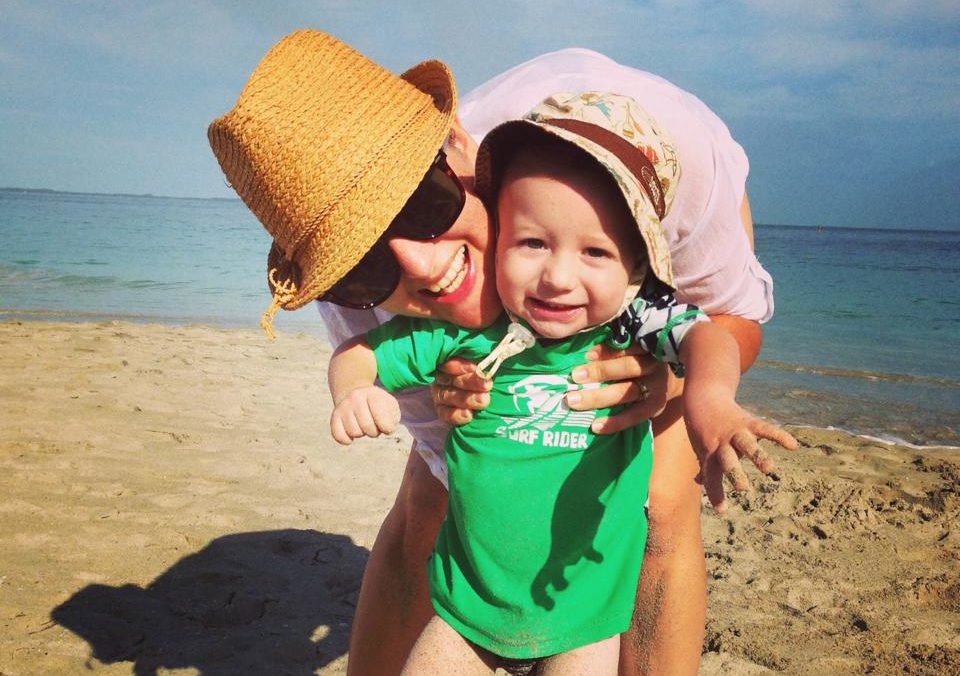
Blue water, sun, and sand are but a few of the interesting elements this theme will make sharing with babies and toddlers possible.
A beach is a magical place, especially to kids. The glorious sound of waves washing up and whooshing back, the feeling of sand squishing between toes, and sun-kissed skin after spending a day outside exploring are the simple yet beautiful things that can make for the sweetest childhood memories. That’s why I try to get my kids as young as babies to fall as madly in love with the beach as I am.
Before you even leave your house, it is wise to prepare for safety and fun. The more comfortable you and your child are, the more fun you’ll be able to have. If you have a sensory sensitive child, build a mini beach for them to get used to the elements. Then be sure to pack plenty of drinking water, snacks, and sunscreen as well as beach toys, towels, sunglasses, aloe, beach blankets, wide-brimmed hats, and tons of toys. Did we mention the toys? Buckets, shovels, sifters, and even blowing bubbles.
Breezy Baby Beach Ideas You’ll Love!
Cover image credit: NadyaEugene/Shutterstock.com
An adventure with a baby can involve a lot of planning, but the effort can be well worth the pleasure of a new experience. Think of it this way — once you get to the seashore, you’ll be able to relax (which parents of babies rarely get to do), introduce your baby to new things, and have some fun together as well.
Our Overview of Successful Trip to the Beach
For a trip to the beach with a baby, plan on setting up a shaded, sand-free play area with a baby pool or beach tent, then provide simple beach toys like buckets and shovels for tactile exploration. Pack essentials like a sun hat, sunglasses, swim diapers, baby-friendly sunscreen (for babies over 6 months), and plenty of snacks.
Create a Safe & Comfortable Play Zone
Shade:
A baby beach tent, sun umbrella, or canopy is crucial to protect a baby's sensitive skin from the sun.Play Area:
For babies who are crawling or putting things in their mouths, set up a small inflatable baby pool and fill it with a small amount of water. This creates a cool, contained play space.Sand-Free Zone:
Play in a baby pool to enjoy water without the wavesUse a large beach blanket and weight down edges
Be cognizant of hot sand
This video demonstrates how to set up a sand-free play area for a baby using a fitted sheet:
Toys & Sensory Play
Simple is Best: Babies will love exploring sand, shells, and seaweed, but a bucket and shovel are simple, effective beach toys.
Waterproof Toys: Bath toys, watering cans, and other small cars and trucks are great options for babies at the beach.
Mesh Bag for Toys: Use a mesh bag to carry beach toys; the sand will fall out as you walk.
Essentials to Pack
Sun Protection: Babies under six months should be kept out of the sun; for babies over six months, use baby-friendly sunscreen.
Baby Beach Tent or Umbrella: A must-have for creating shade.
Baby Pool: An inflatable pool for a contained play space.
Swim Diapers: Essential for keeping the water clean.
Beach Blanket or Towels: For drying off and sitting on.
Snacks & Water: Keep your baby hydrated and fed.
Sun Hat & Sunglasses: To protect their eyes and head.
Baby Carrier: Handy for carrying a fussy baby or creating a soothing nap space.
Safety Tips
Supervise: Always supervise your baby closely, especially when they are near the water, no matter how shallow it is.
Baby-Friendly Beach: Choose a park beach with calm, clean water close by.
Image credit: phBodrova/Shutterstock.com
Whether you plan to travel to an exotic beach overseas or go to a local beach, here are some of the things you need to be prepared for ahead of a beach vacation with your baby and tips on what to pack too!
Expert tip: Looking for fun vacation ideas for families with a baby? You’re in just the right place! We’ve got some cool vacation ideas for families with kids too.
Things to bring with you:
1. Baby sunscreen
Sunscreen is a must when heading to the beach with children as this can help prevent sunburn and sun damage. This is even more necessary with babies because their skin is extra sensitive and needs to be protected. You’ll have plenty of options to choose from where SPF is concerned, including brands that offer sunscreen just for babies.
Image credit: Antonio Gravante/Shutterstock.com
2. Swim diapers
Swim diapers are highly recommended for the beach when spending the day there with your baby. Ahead of your beach day, you’ll have the options of disposable swim diapers or reusable ones, and at the end of the day, that decision is entirely up to you. Regardless of which option you go with, pack a few more than you think you’re going to need, you just might be glad you did later.
Good to know: It is generally recommended that parents wait until their baby is at least 2 months old before taking them swimming in the ocean, a lake, or pool.
3. Diaper bags
Diaper bags are one of those things parents can’t do without when going out with a baby. As diaper changes will absolutely be necessary, these will come in handy during a beach day. Diaper bags can even be useful for storing small items, wet swimsuits, or things you need to throw away as you make your way from the beach to home or back to your resort.
Image credit: haveseen/Shutterstock.com
4. Baby sun hat
There are many adorable options of baby sun hats that you can choose from for your baby’s day at the beach. The purpose of a sun hat will be to protect your baby’s skin from the sun, especially sensitive areas like their nose and cheeks. When selecting baby sun hats, generally, the wider the better as the best options not only protect a baby’s face but their ears and neck as well.
5. Cover-up / rashguard
Cover-ups and rash guards come in handy on the beach to protect your baby’s skin from the sun. This can serve as added protection to sunscreen since, even when it’s carefully applied, some spots can be missed. In addition to keeping your baby’s skin safe, cover-ups and rash guards can help keep sand off your baby’s skin as well.
Image credit: riekephotos/Shutterstock.com
6. Water/baby milk or formula
Water, baby milk, or formula are some of the things you won’t want to leave behind on a beach day with your baby. You’ll need to ensure you have a well-thought-out supply to keep your baby adequately fed and hydrated as you and your family enjoy a day on the beach together. Bring plenty of water as being on the beach can build up a thirst. Water can come in handy if you run out of milk for your baby, and for other members of the family as well.
7. Cooler bag
A cooler bag is a beach vacation must, and parents will know this all too well. If you’ll be going to the beach with a baby, you can use your beach cooler bag to store essentials like baby milk and water, both of which will need to be kept cool. The cooler bag will help you store these items and keep them at the right temperature until you need to use them.
Image credit: Max Davidich/Shutterstock.com
8. Baby shade tent
A baby shade tent will come in handy on beaches where there isn’t much shade. These can also be useful when you need to do diaper changes, or even lay your baby down for a nap. Most parents find this item to be beneficial and generally easy to set up, particularly with a pop-up-style tent. Most baby beach tents have UV protection built in, but this is something you’ll want to double-check before making a purchase.
9. Baby beach toys
Bringing baby beach toys to the beach is a great idea to keep your baby entertained. From beach buckets that you can fill with a small amount of water for splashing to sand molds and animal toys, your baby will be kept well occupied as they get used to the beach environment. For babies, waterproof bath toys can also be a great option as these can easily be washed off afterward. Take a look at our top picks of toddler toys for a beach vacation, some of which babies will love as well.
Image credit: LeManna/Shutterstock.com
10. Portable bassinet or wagon
A portable baby bassinet will be one of those things you’ll be supremely happy you brought along, especially if you’ll be going to the beach with your baby for the first time. This item comes in handy if you want to lay baby down in the shade for a bit, and also for nap time. Your baby will be safe and sound in their portable bassinet, and you’ll be able to place it easily into a beach tent or under an umbrella where you can keep a close eye on your precious little one.
11. Spray bottle
A spray bottle is a simple item you can bring along to the beach to help cool your baby down as you spend some time outdoors. All you’ll need to do is fill your spray bottle with cool water and spritz when necessary. You can use it for baby and for yourself as well, and you can even store it in your beach cooler, so the water stays chilled.
12. Baby beach chair
Let your baby get in on the beachside relaxation with their own baby beach chair. This option is perfect for babies that are old enough to sit up, and it will be a great way to let your baby enjoy the beach views and atmosphere while keeping them from crawling away. An alternative to a baby beach chair can be a bath chair which can be easy to wash the sand from when it’s time to go.
13. Baby float
A baby float works great in calm, shallow waters under the supervision of parents or guardians on the beach. With your baby beach float, you can treat your baby to a new experience in the water as you paddle along, allowing them to be a bit more independent while still being close to you. There are lots of options for baby floats including some that come with a cover to protect the baby from the sun and from small splashes while they’re in the ocean. This one is From Amazon
14. Beach or sand shoes
The sand on the beach can be extra hot, and not great for sensitive baby feet. Sand can be scratchy as well if it gets between little toes. It is best to keep your baby’s feet well protected. Beach or sand shoes can be a great option for this, even if your baby isn’t a walker yet. These will help keep your baby’s feet sand-free, especially if they want to crawl or sit in the sand
15. Infant sunglasses
Your baby can rock some cool sunglasses on the beach that’ll not only protect their eyes from strong sunlight but also allow them to make a fun fashion statement too. As it can be difficult to keep infant sunglasses in place, you can get options with a strap, so they don’t fall off while your baby is moving around on the sand or splashing about near the water.
16. Beach blankets or towels
You definitely won’t want to forget beach blankets or towels when heading to the beach with your kids, and definitely not if you’re bringing along a baby. Blankets come in handy to lay out on the beach to keep your baby off the hot sand, and you’ll need towels to dry off just in case you decide to go with the baby for a dip. You’ll be able to use blankets or towels under tents or umbrellas at the beach as well, which can help keep your baby cool and as sand free as possible.
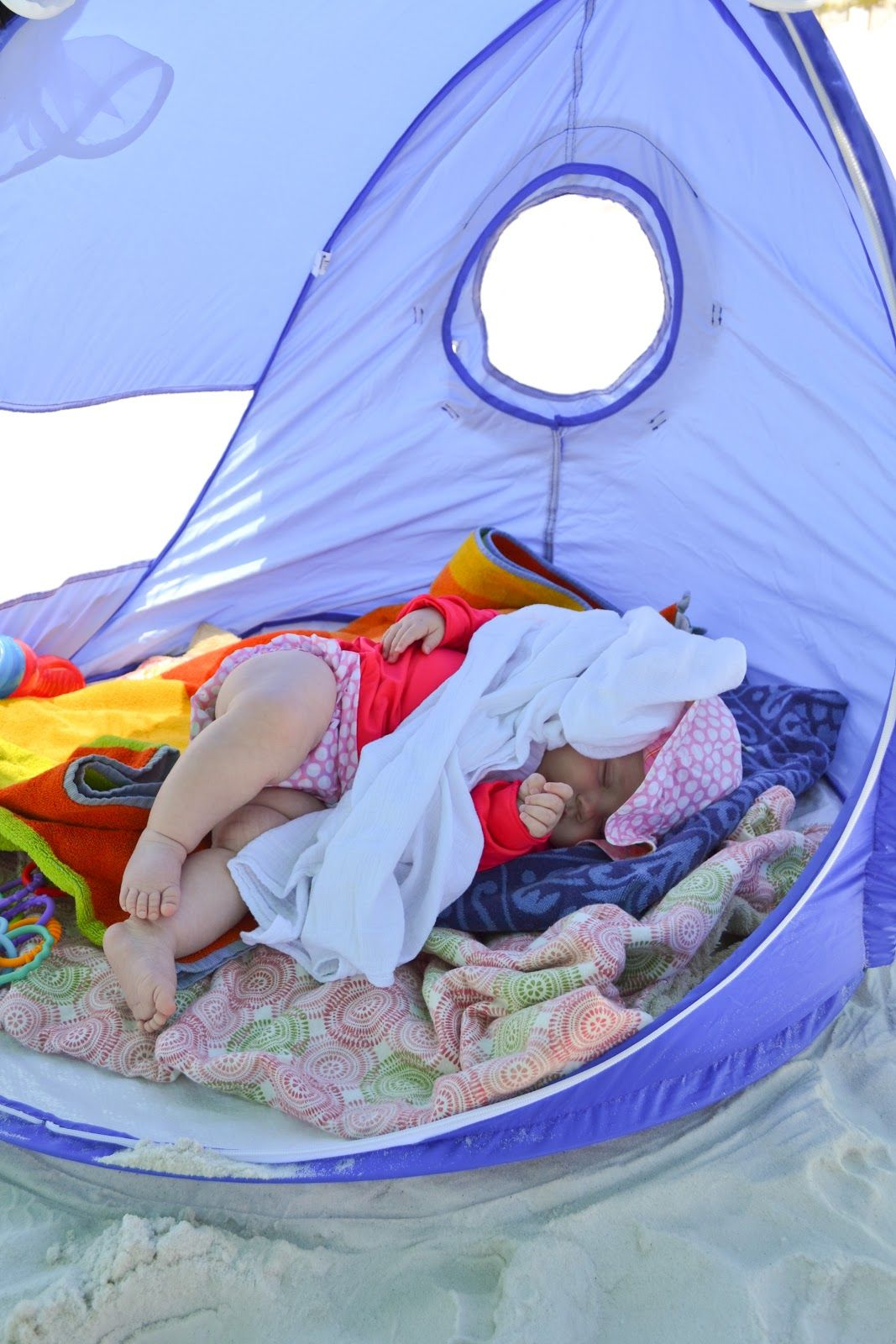
Good to know: Waterproof beach blankets are a great option for the beach as these can easily be kept dry.
17. Waterproof carrier or wrap
A waterproof carrier wrap might just become your favorite baby beach item after a single use. This item is perfect for taking a baby for a quick dip in the ocean, or for a stroll along the seashore as they drift off to sleep. With a waterproof beach carrier, you’ll be able to keep your precious baby close without having to lug along a baby carrier seat, or even a stroller.
Our Favorite Water Friendly Baby Carriers can be used in and out of water.
18. Beach-friendly stroller or wagon
Sometimes strollers are necessary for the beach, but it is important to note that not all strollers are created equal. Ahead of a beach encounter, take some time to do some research and invest in a beach stroller that can help make it easier to navigate the sands with your little one. When looking for a beach stroller, you’ll want to make sure it has sun protection, proper ventilation, and good maneuverability. You’ll also want to be sure it is appropriate for your child’s age.
19. Baby beach bag
A baby beach bag is a must everywhere you go, but it’ll be extra important to have a fully stocked one for a day out on the beach. It is even worth having a separate baby beach bag for the beach so you don’t get your everyday diaper bag wet or sandy. Invest in a large baby beach bag (or a regular bag) with compartments or pockets as this will give you plenty of room for all the essentials, and even to store wet items.
Expert tip: Thinking about traveling to the Caribbean with your family? Ocho Rios, Jamaica’s all-inclusive resorts are great for families looking to enjoy amazing beach days, great service, and quality inclusions.
20. Don’t forget your own things
When heading out to the beach with your baby, your mind will likely be preoccupied with making sure you have everything your little one could possibly need. Don’t forget to pack things for yourself as well, like sunscreen, sunglasses, a swimsuit, towels, lip balm, and whatever you’ll need to be comfortable out at the seashore.
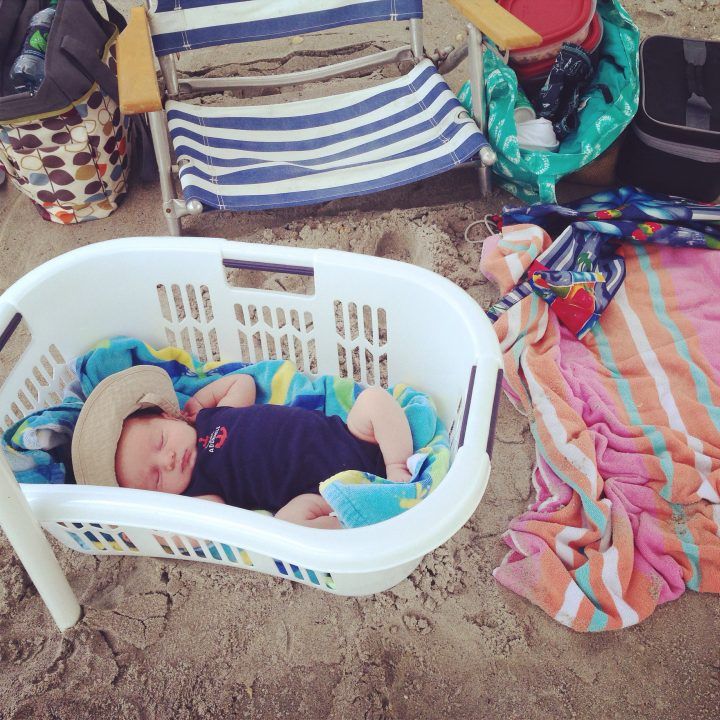
Hacks and tips
21. Set a sunscreen timer
You might not even have considered this one, but it is worth having a timer to help you remember when it’s time to reapply sunscreen. Your sunscreen bottle will tell you how often you’ll need to reapply, and you can set the timer accordingly. A simple timer on a phone or watch will do, and it’ll work wonders in helping keep you and your baby safe from the sun.
22. Keep your water spray bottle in the cooler too
A spray bottle with cool water is worth bringing along to the beach too. You can store this in a beach cooler amid your stash of milk and water and use it to help keep you and your baby cool.
Expert tip: Considering heading on a family vacation to Jamaica? There are lots of things to do in Jamaica with kids, including visiting the most popular Negril resorts some of which have their own waterparks.
23. Pre-freeze snacks - or grab some popsicles
Popsicles are always a hit on the beach as are snacks that are pre-frozen for babies. Ahead of your beach day, you can freeze some pouches of baby food so that by the time you get to the beach, your baby will have something cool and slushy to munch on. If you’re staying at a resort and are not able to freeze baby food pouches and the like, consider getting some popsicles, which can be a great way to keep your baby hydrated.
24. Remove sand with baby powder or cornstarch
Baby powder or cornstarch is useful for much more than you might think. Out on the beach, you might be able to use these to clean your baby’s sandy feet and even your own, which can be a lot easier than using towels or making multiple trips back to the ocean with a bucket. These products soak up the water from the sand making it easy to brush the sand off, which you’ll definitely appreciate during a family beach day.
25. Plan your timing around the temperature
It is important to plan the timing of your beach day carefully when going with a baby. If you go too early in the afternoon, you might find yourself out on the beach at a time when the sun is at its hottest. Earlier in the day or late afternoon can work best when going to the beach with your baby, as the sun tends to be a little milder then. Consider also planning your beach day around nap and feeding times, which can help make things run more smoothly overall.
26. Pack ahead - you don’t want to overload yourself
If you’re planning a beach day with family, don’t wait until the last minute to pack. Doing so can lead to you scrambling around to find things on the day and even packing things you don’t need. Get around this by preparing a packing list in advance and using it to get things in order in the days leading up to your outing. A packing list can help ensure that you don’t overpack as well.
27. Use the beach as a sensory play experience
The beach is the perfect place for some sensory play if you’ll be spending the day there with your baby. Things like the sand, shells, rocks, and all the other textures and colors that can be found on the beach will be a source of fascination for your baby. Be sure to pay careful attention to whatever your baby is playing with by making sure shells aren’t too sharp and rocks aren’t small enough to be a choking hazard.
Expert tip: Place some sand in a bucket and let your baby feel the sand when it is wet versus when it is dry. This can be a great sensory experience.
28. Choose a beach with shallow water
Beach selection can help shape your day on the beach with your baby. While parents will need to supervise babies and kids at all times no matter which beach they choose, it makes sense to choose a family-friendly beach with calm, shallow water that can help parents feel more at ease. Beaches with shallow water will make it easy for you to take your baby for that first dip in the swallows, even if it's just their toes!
Expert tip: Planning a beach vacation in Jamaica? Here are some of the best beaches in Jamaica that you can explore with your family.
29. Relax! It’ll keep your baby relaxed too
The most important thing to remember when spending a beach day with your family is to relax. Everyone, baby included, is at the beach to have a good time, and that should be the ultimate focus. Plus, when you’re calm and cool, chances are your little one will be too.
Expert tip: Just about ready to head out on your vacation? Have a look at our family vacation checklist to be super sure you have all you need!
Explore the Seashore
Shores are an important place for us as a family, and we feel fortunate that we explored so many of Americas eastern shores of them with our daughter. The shore is endless family fun at your fingertips, and for those of us who don’t get to the beach but once a year, there’s so much exploring to do, that it’s nuts. The beach is an ideal place to really focus on raising curious kids–kids who observe, who question, who wonder, and who want to learn more.
So, I always packed some things from home for exploring and playing in the new environment. Sometimes I grabbed her vehicles, blocks, cookie cutters, sand toys or figurines from her sandbox. I also wanted her feel free to collect some things that intrigued her at the beach in her bucket for her playtime explorations and art supplies at home.
Introduce Salt Water with Care
Before You Go
Check Water Conditions: Inquire about water temperature, cleanliness, and calm conditions from a lifeguard, especially if you are new to the beach.
Sun Protection: Use a wide-brimmed hat and apply baby-safe sunscreen to protect their sensitive skin.
Gear Up: Bring swim diapers (not regular ones), a swim suit, and plenty of towels and shade.
How to introduce your baby to the ocean/salt water:
Babies should be calmed and relaxed from your slow and gentle movements, after a few minutes. After all, those gently lapping waves can remind them of being in the womb, so you may see your baby return to a state of fetal bliss.
You can also Use a baby float if you have one.
To introduce your baby to the ocean, let them feel the water on their toes first in very shallow, calm water, ideally with warm conditions and a lifeguard present. Use this gentle approach to build comfort and always prioritize their safety by supervising them closely, ensuring they're shielded from the sun, and keeping water sessions short to prevent chilling.
Avoid letting babies under 12 months swallow salt water, as their underdeveloped kidneys cannot handle it, and ensure they do not get cold.
Start Shallow : Let your baby splash in the small puddles and shallow water at the shoreline to get comfortable with the sensation of waves and water movement. Gentle & Gradual : Keep sessions short and gentle to prevent the baby from getting cold, as they can't regulate their body heat as well as adults. Close Supervision : Always stay within arm's reach of your baby to ensure their safety in the water. Avoid Swallowing Water : Be vigilant about keeping salt water out of your baby's eyes, nose, and mouth.
Warm Up : Dry your baby and take them to a shaded area to warm up. Consider a Shower : If possible, a shower after the beach can help rinse off any lingering salt water from your baby's skin and hair.
Plus, you’ll give them early exposure to nature, building an appreciation for being outdoors that can help them develop a healthy lifestyle as they mature.
Try some simple water play like
Dipping their toes in the warm water then their legs., then to their waist. But know that not all babies are ocean lovers.
Take turns getting in shallow water with your little one to help them enjoy the waves.
I hope you enjoyed these great tips for taking your baby to the beach.
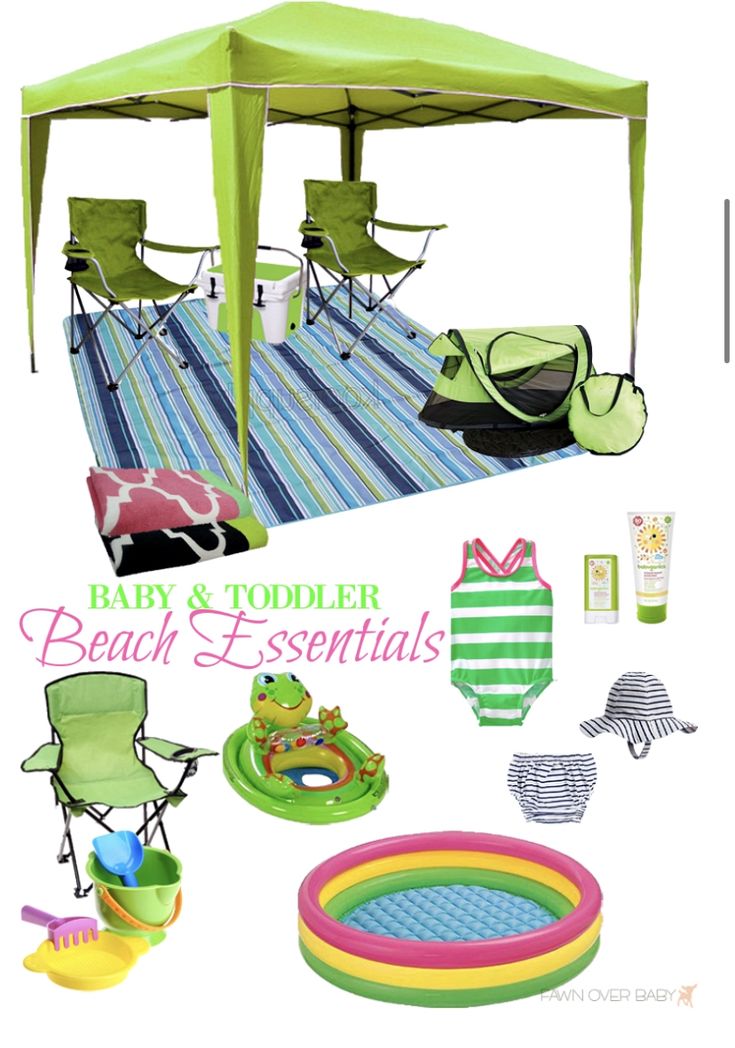
Only Bring What Is Necessary
Ensuring that you have all the beach essentials for the baby is super important, but do not go overboard. Pack light for easy travel, load the wagon and skip the toy box.
On a beach trip, you do not need to bring much to entertain your little one. You are the greatest toy for them. Other than you, you can do a teething toy or two, a shovel, sand toys, and a bucket, and you are good to go. The action and playing in the water will keep your young one entertained.
Realize that a day at the beach means you’re actually parenting in a more challenging place, so finish the day feeling like a warrior for surviving. Soak up the family time together whether it’s enjoyable or a disaster (those days make for great stories later).
PLANNING A BEACH TRIP WITH A BABY
Check out my Family Vacation Planning Series for tips from budgeting, to finding cheap flights, to planning your itinerary!
Baby Travel Essentials [What to Bring and What NOT to Bring]
10 Tips for Visiting Disney with a Baby
Florida Spring Break Destinations for Families
